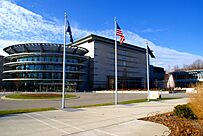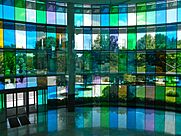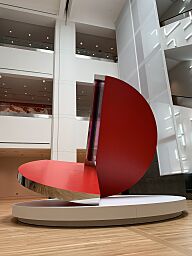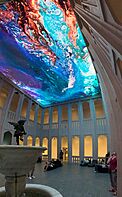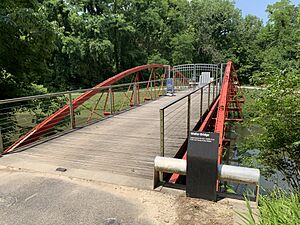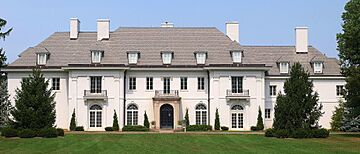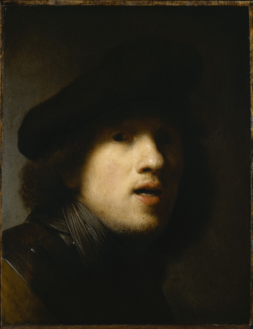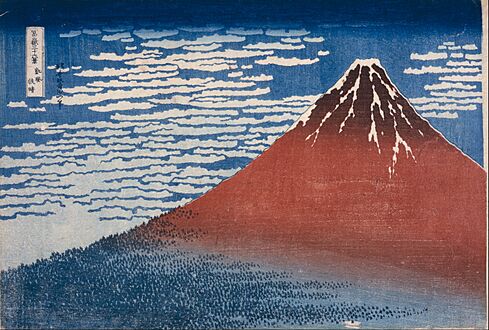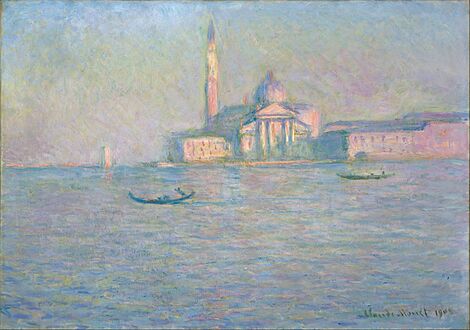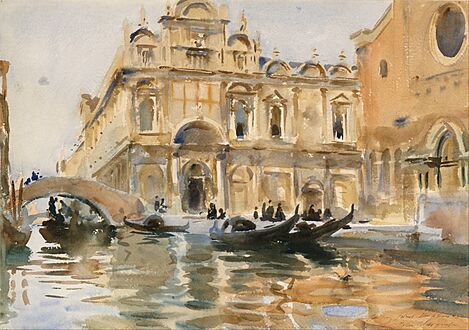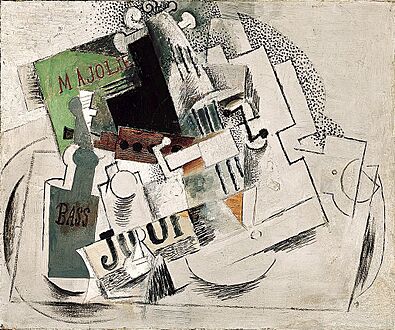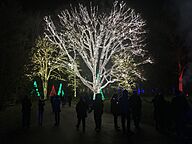Indianapolis Museum of Art facts for kids
 |
|
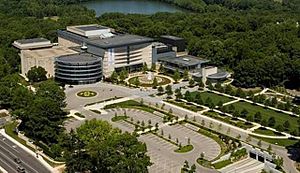
An overhead view of the Newfields campus, located in Indianapolis, Indiana, United States.
|
|
| Established | 1883 |
|---|---|
| Location | 4000 Michigan Road Indianapolis, Indiana, U.S. |
| Type | Art museum |
| Collection size | 54,000 |
| Visitors | 442,500 (2019) |
| Public transit access | |
The Indianapolis Museum of Art (IMA) is a large art museum located at Newfields, a 152-acre campus in Indianapolis, Indiana. Besides the main museum building, the Newfields campus also includes the historic Lilly House, The Virginia B. Fairbanks Art & Nature Park, and beautiful gardens. The entire place offers a mix of art, nature, and history for visitors to explore.
The IMA is one of the oldest and largest art museums in the United States. Its collection includes over 54,000 works of art from all over the world, including Africa, America, Asia, and Europe. Some of the most famous artworks are Neo-Impressionist paintings, Japanese art from the Edo period, and many pieces by the artist J. M. W. Turner. The museum also has a great collection of modern art and design.
The museum was founded in 1883 as the Art Association of Indianapolis. One of its founders was May Wright Sewall, a leader in the women's suffrage movement, which fought for women's right to vote. In 1970, the museum moved to its current home at Newfields.
Over the years, the museum has been known for its new ideas, like using technology to share its art with more people. In 2009, it won the National Medal for Museum and Library Service for its excellent public service and educational programs.
Contents
History of the Museum
How It All Started (1883–1969)
The museum began in 1883 as the Art Association of Indianapolis. It was started by a group of people, led by May Wright Sewall, who wanted to teach the public about art. Their first art show had 453 artworks by 137 different artists.
When a wealthy man named John Herron passed away in 1895, he left money to build an art gallery and school. The John Herron Art Institute opened in 1902, and its museum opened in 1906. For many years, the museum grew its collection with the help of generous people who donated art and money.
In 1966, the family of businessman Eli Lilly donated their large estate, called Oldfields, to the museum. This gave the museum a new, much larger home. In 1969, the organization changed its name to the Indianapolis Museum of Art, and it opened at the new location in 1970.
Moving to a New Home (1970–2011)
The new location at Oldfields allowed the museum to grow. The first new building, the Krannert Pavilion, opened in 1970. More buildings were added over the years to hold more art and provide space for visitors. This included the Clowes Pavilion, which holds a famous collection of Old Master paintings.
In 2005, the museum finished a huge $74 million renovation. This project added three new wings and gave the museum 50% more gallery space. The goal was to make the museum more welcoming and easier for visitors to explore.
Maxwell L. Anderson became the director in 2006. During his time, the museum opened the Virginia B. Fairbanks Art & Nature Park and acquired the famous Miller House and Garden, a masterpiece of modern design.
Recent Years and Changes
Charles L. Venable became the director in 2012. He focused on making the museum more popular and financially stable. This included adding fun events like outdoor minigolf with holes designed by artists.
In 2017, the entire campus was renamed Newfields to bring the museum, gardens, and park together under one name. The main building is still called the Indianapolis Museum of Art (IMA), but it is now "at Newfields." This change was part of an effort to attract a wider audience with new events like the popular Winterlights festival.
In 2021, the museum faced challenges after a job posting caused controversy. This led to leadership changes and a renewed commitment to welcoming all parts of the community. Colette Pierce Burnette became the first Black woman to lead the museum in 2022. After she left in 2023, the museum continued its work under new leadership. Today, Le Monte Booker is the President and CEO, and Belinda Tate is the Director of the IMA.
What to See at Newfields
Indianapolis Museum of Art (IMA)
The IMA is the main building at Newfields and home to the museum's amazing art collection. Inside, you'll find the ticket office, a gift shop, and a café. The building also has several large spaces for events and performances.
The Lume
The fourth floor of the museum is home to The Lume, a huge 30,000-square-foot digital art gallery. Instead of paintings on a wall, art is projected all around you, creating an immersive experience. Past exhibits have featured the works of artists like Vincent van Gogh and Claude Monet.
Pulliam Family Great Hall
The Pulliam Family Great Hall is a large, open space where you can see several huge works of art. This includes the original LOVE sculpture by Robert Indiana, which is a very popular spot for photos. The hall connects to most of the museum's other galleries.
Clowes Pavilion
The Clowes Pavilion is dedicated to the art collection of the Clowes family. It features many famous Old Masters paintings, including a self-portrait by Rembrandt. After a major renovation, the pavilion reopened in 2022 with a stunning LED screen covering the entire ceiling of its courtyard.
The Virginia B. Fairbanks Art & Nature Park
This 100-acre park is one of the largest art parks in the country. It features forests, a lake, and hiking trails that lead you past large, outdoor artworks. One of the most famous pieces is Funky Bones, a giant sculpture made of bone-shaped benches. The park is a great place to experience art in a natural setting.
Lilly House
Lilly House, also known as Oldfields, is a beautiful historic mansion on the Newfields campus. It was once the home of the Lilly family. Today, it is a museum where you can see what life was like in the 1930s. The house and its stunning gardens are a U.S. National Historic Landmark.
The Garden at Newfields
The campus has many beautiful gardens to explore. Near the museum, you can see the Sutphin Mall, which features the sculpture Five Brushstrokes by Roy Lichtenstein. The historic gardens around the Lilly House include the Allée, a long lawn lined with oak trees, and the peaceful Rapp Family Ravine Garden.
The Art Collection
Newfields has a collection of over 54,000 artworks that span 5,000 years of history from around the globe.
- European Art: This collection includes famous paintings by artists like Rembrandt, Jusepe de Ribera, and Paul Gauguin. It is especially known for its collection of Neo-Impressionist art, including The Channel of Gravelines, Petit Fort Philippe by Georges Seurat.
- American Art: Here you can find works by famous American artists like Georgia O'Keeffe, Winslow Homer, and Edward Hopper. Hopper's painting Hotel Lobby is a well-known piece in the collection.
- Asian Art: The museum has over 5,000 pieces of Asian art. Its collection of Japanese paintings from the Edo period is considered one of the best in the world.
- African Art: The collection includes over 2,000 objects from across Africa. It features both historical artifacts and modern artworks.
- Textiles and Fashion: With over 7,000 items, this collection includes everything from historic fabrics to dresses designed by famous fashion houses like Chanel and Givenchy.
-
Jusepe de Ribera, Aristotle (1637)
-
Rembrandt van Rijn, Self-portrait (1629)
-
J. M. W. Turner, The Fifth Plague of Egypt (1800)
-
Katsushika Hokusai, Fine Wind, Clear Morning (c. 1830–1832)
-
Paul Gauguin, The Flageolet Player on the Cliff (1889)
-
Georges Seurat, The Channel of Gravelines, Petit Fort Philippe (1890)
-
Claude Monet, The Church of San Giorgio Maggiore, Venice (1908)
-
John Singer Sargent, Rio dei Mendicanti, Venice (c. 1909)
-
Pablo Picasso, Ma Jolie, Nature Morte (Musique) (1913–14)
Fun Festivals and Events
Winterlights
Every winter, the Newfields campus is decorated with over a million twinkling lights for Winterlights. The festival includes a light show that is synchronized to music. It has become a popular holiday tradition in Indianapolis.
Harvest Nights
In the fall, Newfields hosts Harvest Nights. This event features thousands of glowing jack-o'-lanterns along a spooky path. There is also a light show projected onto the front of the Lilly House that tells a ghost story.
See also
 In Spanish: Museo de Arte de Indianápolis para niños
In Spanish: Museo de Arte de Indianápolis para niños
- List of largest art museums
- List of museums in Indiana
- List of attractions and events in Indianapolis





